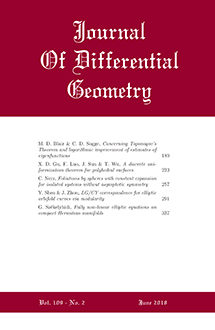Abstract
We present a classification of compact Kähler manifolds admitting a hamiltonian 2-form (which were classified locally in part I of this work). This involves two components of independent interest.
The first is the notion of a rigid hamiltonian torus action. This natural condition, for torus actions on a Kähler manifold, was introduced locally in part I, but such actions turn out to be remarkably well behaved globally, leading to a fairly explicit classification: up to a blow-up, compact Kähler manifolds with a rigid hamiltonian torus action are bundles of toric Kähler manifolds.
The second idea is a special case of toric geometry, which we call orthotoric. We prove that orthotoric Kähler manifolds are diffeomorphic to complex projective space, but we extend our analysis to orthotoric orbifolds, where the geometry is much richer. We thus obtain new examples of Kähler–Einstein 4-orbifolds.
Combining these two themes, we prove that compact Kähler manifolds with hamiltonian 2-forms are covered by blow-downs of projective bundles over Kähler products, and we describe explicitly how the Kähler metrics with a hamiltonian 2-form are parameterized. We explain how this provides a context for constructing new examples of extremal Kähler metrics—in particular a subclass of such metrics which we call weakly Bochner-flat.
We also provide a self-contained treatment of the theory of compact toric Kähler manifolds, since we need it and find the existing literature incomplete.
Citation
Vestislav Apostolov. David M.J. Calderbank. Paul Gauduchon. Christina W. Tønnesen-Friedman. "Hamiltonian 2-forms in Kähler geometry, II Global Classification." J. Differential Geom. 68 (2) 277 - 345, Oct 2004. https://doi.org/10.4310/jdg/1115669513
Information





